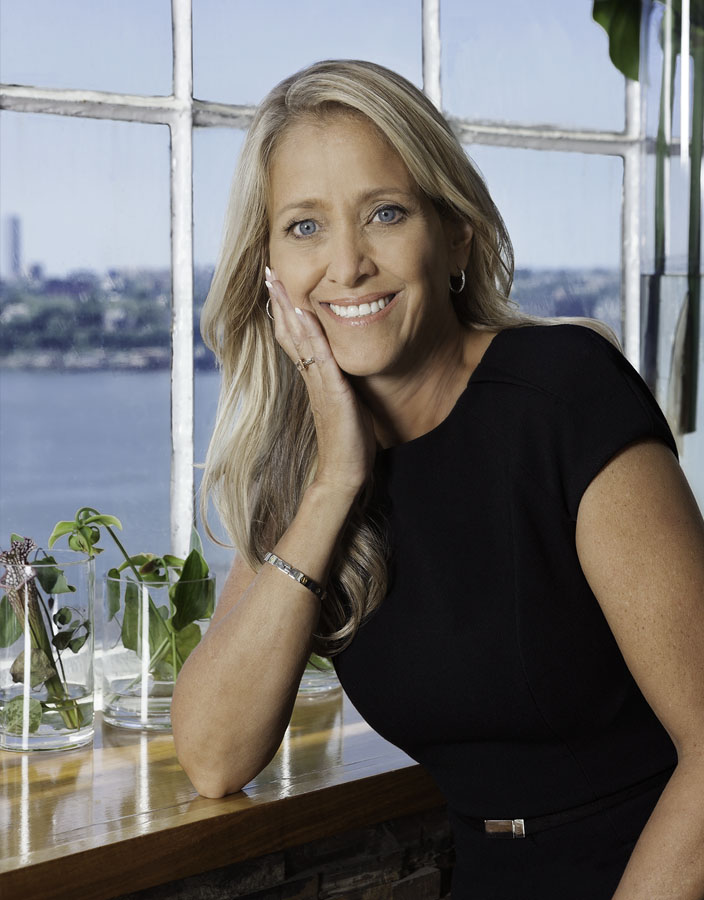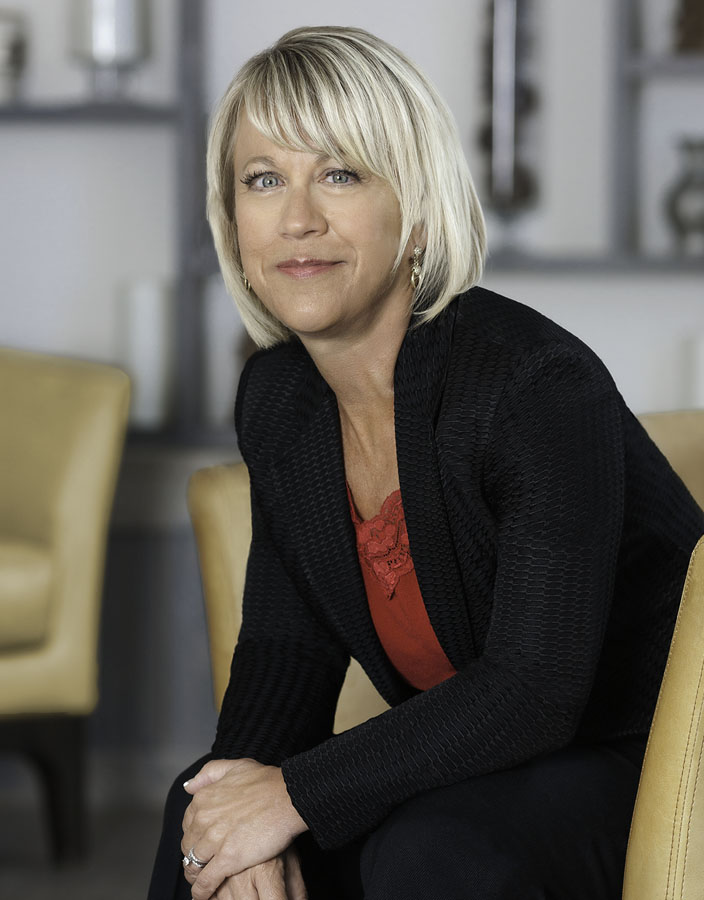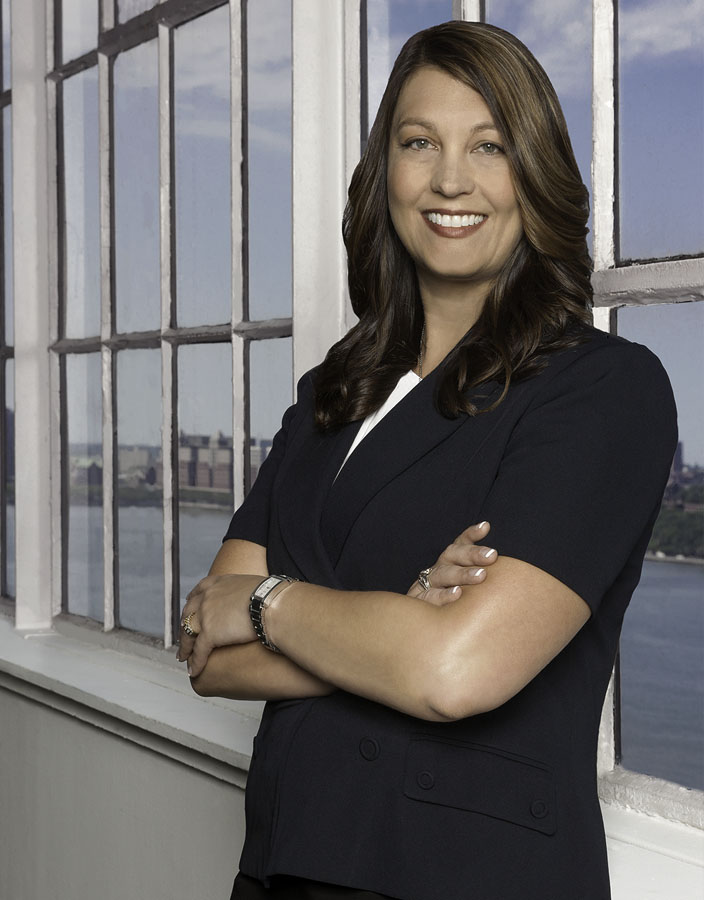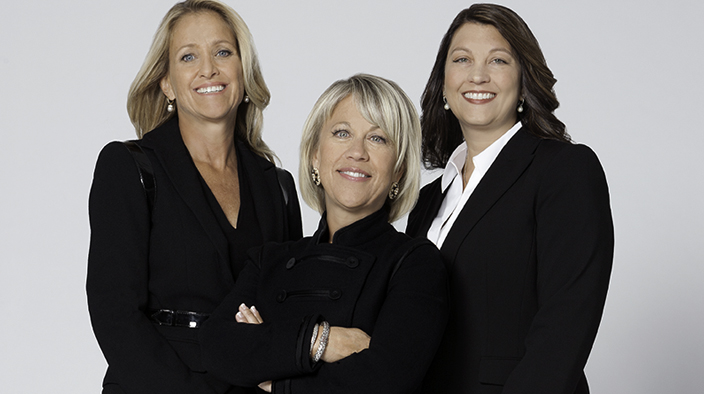From left to right: Jennie Fisher, SVP and GM, Office Equipment Group, GreatAmerica Financial Services; Carol Cannata, SVP, Creative & Client Services, The Cannata Report; Beth Ann “BA” Kilberg-Walsh, VP, Marketing Communications and Customer Engagement, Xerox Corporation; Tina Cartwright, SVP, Equipment Finance Information Technology, U.S. Bank.
Tenacious. Versatile. Passionate. Empowering. These are just a few of the words we could use to describe this year’s Special Women Influencers issue cover and cover story subjects Tina Cartwright, Jennie Fisher, and Beth Ann (BA) Kilberg-Walsh.
Coming from diverse backgrounds, none of these women had their sights set on the imaging technology and workplace solutions industry when they began their careers. However, once they found their footing in this business, each woman established herself quickly and began a steady climb up the corporate ladder to her current role. Today, these three women embody the word “influencer” by leading by example and pursuing the right opportunities for their companies, their teams, and themselves.
Jennie Fisher
SVP and GM, Office Equipment Group, GreatAmerica Financial Services
 Leading with Integrity
Leading with Integrity
As one of GreatAmerica Financial Services’ first employees, Jennie Fisher, currently GM and SVP of the office equipment group, has been able to carve a distinct path for herself. After eight years working at two separate law firms, she took a position at GE Capital, hoping to grow, learn, and develop a new career path. At the same time, she was pursuing her college degree in the evenings. She says she really had no clue about the great opportunity in financing copiers and faxes when she took the job.
At GE Capital, Fisher worked closely with Tony Golobic, who would become the founder, chairman, and CEO of GreatAmerica. He also encouraged her educational and professional pursuits. As many in the industry know, Golobic has been greatly supportive of women not only in the workforce””having founded GreatAmerica with three women as the company’s first employees””but also in leadership positions. And he clearly identified Fisher as a rising star in the financing industry.
“A leader can make a huge difference in your life, and for me, it certainly was Tony,” said Fisher, who followed Golobic to GreatAmerica about six months after the company launched. She credits him with showing her how she could achieve anything she wanted to, buoying her confidence, and teaching her strong business ethics and integrity.
Coming in at the ground level at GreatAmerica gave Fisher a real bird’s eye view of what it took to run the company. Having worked behind the scenes with Golobic as he developed the company’s business plan, Fisher had a deep understanding of his vision and goals. She came into her role at the company prepared to do whatever it took to make GreatAmerica successful.
“One day I was typing up legal documents or proposals to send to the bank communities, the next I was collecting on customers and doing cash applications,” said Fisher. “I did a little bit of everything except work on IT equipment. As we were able to obtain funding and brought in our first couple of sales reps, I did a lot of marketing work around our go-to-market strategy and how we wanted to promote GreatAmerica.”
As senior vice president and general manager of the office equipment group at GreatAmerica, one of the company’s eight business lines, Fisher is responsible for the overall sales, marketing, operations, financial performance, and growth of the unit. At GreatAmerica, the office equipment industry is the company’s core, generating approximately 65% of annual revenue for GreatAmerica.
“I’d like to think my leadership style is democratic””listening, getting buy-in, and building team cohesiveness,” said Fisher. Although, she says, it wasn’t always this way. When she was a sales team leader, her style was more autocratic. She was a driver, a hard worker, and felt everyone needed to be that way. However, over several years, Fisher learned that wasn’t the best way to work with people.
Much of that experience came from distinguishing herself from a manager, who works on the day-to-day, tactical management of projects, to a leader, who sets the tone and vision of the team.
“We are all individuals; we’re all motivated by different things” said Fisher. “At the end of the day, you have to set the goal, communicate the expectations, and let people get there on their own.”
Fisher has surrounded herself with a talented team of senior level executives and she strives to bring that team together to develop ideas themselves. Fisher then works closely with them to refine the strategy.
“I try to be in tune with the individual, emotional needs and constraints of the employees,” said Fisher. “Another thing I’ve learned is that if you don’t care for your employees, they’re not going to care for the company, or care for you.”
Fisher always has her team’s growth in mind. She knows their strengths and challenges, and helps them gain exposure to different assignments that will improve their development areas. She also provides positive and constructive feedback. All of her efforts are to make sure her team knows where they stand with her.
Despite her senior role, Fisher is still striving to continue learning and succeed in the industry. “Surround yourself with good people””people who are more sophisticated than you, better than you, smarter and more skilled than you,” said Fisher. “Ultimately, you’ll strive to be them. It’s going to take you up a notch. Your success is driven by you, but it’s also a team effort. Most successful people don’t do it alone.”
Fisher also maintains that ethics and integrity play an extremely important role in building a successful career and being an effective leader.
“Do the right thing and do it consistently,” said Fisher. “Back in my younger years, I remember a couple of decisions that probably weren’t the right ones, but I learned my lessons from them. When you go to bed at night, don’t be challenged going to sleep because of what you did.”
* * * * *
GreatAmerica’s Managed IT Peer Groups
Over the past two years, GreatAmerica has spearheaded an effort to bring additional resources and solutions to dealers through managed IT peer groups, one of the value-added resources the company has brought to the community outside its core product of financing.
About five years ago, GreatAmerica recognized the trend of dealers looking to add revenue streams adjacent to their core business of products, which for many involved offering solutions, specifically down the IT path. As a result, Jennie Fisher and David Pohlman, executive vice president and COO of GreatAmerica, set about learning how the company could best support dealers in this endeavor. Collaborating with Paul Dippell, founder and former CEO of All Covered, they began holding strategic information sessions with office equipment dealers to educate them on how to be successful in offering IT services.
Taking this effort one step further, in 2014, GreatAmerica and Dippell established IT peer groups known as S-L GAMIT (Service Leadership GreatAmerica Managed IT) groups, which are designed to help dealers achieve best-in-class managed IT services performance, as measured against peers.
While Dippell runs the quarterly sessions with his company Service Leadership, GreatAmerica subsidizes a portion of the cost, which allows executives from GreatAmerica to attend the sessions to learn alongside the dealers.
There are currently 28 dealer participants that are separated into four groups. They meet in person three times a year for a day-and-a-half and by webinar for one meeting per year. There is a set curriculum to review dealer financials and the number of deals closed versus their goals. The groups then tackle other important areas such as operations, sales, or marketing.
For dealers, according to Fisher, the primary benefit of these peer groups is to network with other peers who are offering IT services, as well as develop benchmarks for themselves. For GreatAmerica, Fisher says the groups give the company a window into the dealer experience, allowing executives to deeply understand the challenges facing dealers in offering IT services so GreatAmerica can work to better help dealers.
* * * * *
Beth Ann “BA” Kilberg-Walsh
VP, Marketing Communications and Customer Engagement, Xerox Corporation
 Collaborating with Respect
Collaborating with Respect
When Beth Ann Kilberg-Walsh, now VP of marketing communications and customer engagement, started at Xerox 20 years ago, she already had a successful career in advertising, and even started and sold her own company. Her first job out of college was selling advertising for a company that printed Catholic church bulletins. She moved into selling direct marketing for a direct mail house and then advertising for a local newspaper in Rochester, New York. All of these valuable experiences provided Kilberg-Walsh with a strong foundation in marketing across local communities.
With a wide breadth of experiences under her belt, Kilberg-Walsh had the itch to open her own agency. Combining the business models of advertising sales with the weekly church bulletins, direct mail, and newspapers, she opened her own company with the concept of selling advertising on the back of New York state park maps.
After five years, however, she was ready for her next opportunity and sold her company. A former colleague mentioned some openings at Xerox.
“Immediately when I interviewed with a few different people, the light bulb went on to say, I can do this, and I can fit in here,” said Kilberg-Walsh. “I was surprised that Xerox was a very big company, a Fortune 500, but there was also that small, family atmosphere that drew me in, and still draws me in today.”
In her current role, she is charged with creating brand awareness for the company’s production products and marketing them to commercial printers and large enterprises that have in-plant print shops. To do this, Kilberg-Walsh oversees events, traditional marketing communications, business development tools, and a premier partner program on a global basis.
“It’s a challenge when you’re responsible for global activity,” said Kilberg-Walsh, who works in teams to ensure they are listening to everyone’s perceptions and needs and applying them as best as possible to tailor Xerox’s marketing efforts, particularly in different markets. “What might be required here in New York or California may not be the same in London. It’s important to be working collaboratively and gathering requirements from our customers so we can customize and personalize based on a particular customer set in a particular geography.”
When it comes to managing her team, Kilberg-Walsh emphasizes respect. “While we are so extremely busy in both our home lives and business lives””we’re all tired and we all work a lot””respect is key. We all have different opinions and we need to respect each other in expressing those opinions.”
Collaboration is another important aspect Kilberg-Walsh highlights. We all know that there isn’t one person behind building an entire business, but rather it’s through the cooperation across several people that goals and successes are achieved. Kilberg-Walsh wants to empower her team so they feel a sense of accomplishment and pride.
“While I take decisions very seriously, I want to make sure we have collaborative effort in making those decisions,” said Kilberg-Walsh, who encourages employees to have confidence, be themselves, continue learning, and network to leverage their community in their efforts to grow in their careers.
Networking has proven to be an invaluable building block in Kilberg-Walsh’s career at Xerox. As a member of Xerox’s Women’s Alliance, she developed marketing and collateral for the caucus group within the company, eventually serving as president of the group. Through sharing her experiences and listening to others within the Women’s Alliance group, Kilberg-Walsh says she has learned that no matter what level an employee is at in a company, they each have their own individual needs, desires, and challenges, but by working together and sharing stories, all can benefit.
“While I’ve helped mentor others and others have helped mentor me, I’ve continued to learn,” said Kilberg-Walsh, who cites her own parents as the biggest influences in her life. She says she inherited her strong work ethic from her father, Don Kilberg, who worked for a utility company in Illinois for over 40 years, while she picked up her positive attitude from her mother Shirley.
“You are dealt these challenges””whether it’s from a business decision, the economy, the budget, whatever it may be,” said Kilberg-Walsh. “My mother would say that if you take the choice and the path to being positive, that positive attitude will spill over to everyone around you. I’ve carried that guidance with me throughout my career. It’s infectious.”
Drawing on her own experience from her first days at Xerox, Kilberg-Walsh advises young people””women, in particular””to be patient and soak up as much as they can to keep learning. Most importantly, she says that people shouldn’t be afraid to ask questions.
“Many times, women feel like the can’t come forward, that we’re supposed to have answers or if we ask questions, we’re not as smart or it’ll be taken the wrong way,” said Kilberg-Walsh. “But I’d say, be patient, don’t ask to many questions right away, and learn. But then, start asking those questions. At the end of the day, we all learn from them.”
* * * * *
Xerox’s drupa Showcase over Two Years in the Making
When Xerox made its appearance at this year’s drupa in Germany, the Olympics of graphics trade shows, Beth Ann Kilberg-Walsh’s team was one of the major players behind the company’s efforts. In conjunction with Xerox’s corporate marketing, global operations, finance, supplies, and several other groups, Kilberg-Walsh worked for over two years to prepare for the show.
“There was a lot of thought, strategy, partnership, and passion that went into the planning,” said Kilberg-Walsh. “But most importantly, at the end of the day, we had fun. You don’t produce a show like that without having the partnership across the globe, both internal and external, and a respect for others.
Xerox was among 2,000 exhibitors that occupied over 12 square miles of space in various convention halls. Xerox alone had a 25,000 square-foot stand that showcased 18 Xerox print engines, 14 workflow stations, and various XMPie solutions.
Of the 260,000-plus attendees at drupa, more than 3,000 attendees took guided tours of the Xerox exhibit. The company had over 650 attendees at its Xerox Forum and hosted more than 4,000 attendees in its VIP Lounge and 10,000 at its Happy Hour.
Xerox also produced 55 live broadcasts, with nearly five hours of video reaching approximately 40,000 viewers. Its combined efforts gave the company the No. 1 share of voice at the show. The company also produced almost 600 pieces of pre- and post-drupa coverage, garnering over 20 million impressions. There were 150 global press and analysts represented at Xerox’s news briefings at the show.
Preparation for the major event required a massive amount of coordination and collaboration across the entire company.
“Having that same common goal, we all walked down that same path, sometimes with a few detours, and I couldn’t be happier with the end result,” said Kilberg-Walsh.
* * * * *
Tina Cartwright
SVP, Equipment Finance Information Technology, U.S. Bank
 Choreographing a Career
Choreographing a Career
When Tina Cartwright, SVP of U.S. Bank’s equipment finance information technology group, entered college, technology and education were not anywhere on her radar. Her dream was to eventually join a major company as a professional ballet or modern dancer. Very quickly, though, she realized the life of a principal dancer was not what she had envisioned.
Cartwright shifted her focus to accounting, having gravitated toward the numbers and structure of this area of study. During her college years, she worked as a part-time data entry specialist for the Manifest Group, a division of Lyon Financial, which is an independent financial company owned by Swann’s Ice Cream. After receiving her degree in business management and accounting, she chose to remain with Manifest, appreciating the company’s culture and the opportunities for growth. Cartwright transitioned into an underwriting role as a credit analyst, ultimately becoming a credit manager.
In 2000, U.S. Bank purchased Lyon Financial, opening more doors for Cartwright. It was at this inflection point that she began exploring the technical side of the financial business, having been asked to assist in the bank’s conversion process as a systems analyst.
“I was very intrigued by the technology and the inner workings and problem-solving aspects of my responsibilities during that period,” said Cartwright, who continued to take on numerous project management roles that exposed her to more technical projects on the bank side. Cartwright went on to spend about 10 years working on various projects, most specifically, credit scoring updates and reporting initiatives.
Today, in her role managing U.S. Bank’s information systems, Cartwright is responsible for the equipment finance divisions, focusing on information technologies, security, project management, and professional development programs in the U.S.
“I’m really responsible for working closely with the leaders of each of the lines of business as a liaison to assure our technology and education strategies are in alignment with each of our business line initiatives and objectives,” said Cartwright.
Overseeing the seven lines of business within equipment finance, including office equipment, Cartwright views herself as a continual learner, looking to understand and be a part of U.S. Bank’s global perspective. As a true connector, Cartwright says her ability to connect and navigate through many different types of opportunities has helped propel her to her current leadership role.
“The greatest challenge and reward is the amount of opportunity my role presents and being able to make such an impact on the company, with technology and education both as foundational components to continue growing the success of individuals and our industry,” said Cartwright.
When it comes to leading her team of seven direct reports and negotiating across the U.S. Bank’s multiple lines of business, Cartwright’s management style is situational, given the constantly changing landscape of the industries she serves.
“Throughout my career, I’ve learned that leaders have to adapt not only to the situation but also to the individuals and the environment around them,” said Cartwright. “Each of these can and do change. Having a greater awareness to understand allows you to adjust accordingly to provide those higher levels of success.”
Depending on the issue at hand, Cartwright has been known to roll up her sleeves to help problem-solve with her team members. However, she also knows when to take a step back to let them navigate through situations to determine the best course of action.
“The key is building trust and credibility and providing a safe and challenging work environment,” said Cartwright. “Yet, having that transparent, open, and honest communication is what allows a team to thrive.”
Cartwright also views mentors as important touchstones in helping stoke personal and professional growth. Over her career, Cartwright has had numerous mentors who have counseled her in moving from solely focusing on day-to-day management of tasks and responsibilities to thinking more strategically and globally.
In mentoring young professionals, Cartwright encourages them to be true to themselves, carrying forward their own goals and ambitions and not letting the influences of the world around them impact what they’re doing. She also wants them to feel empowered in pursuing their goals. “As young professionals come up through the ranks, it can be hard to learn to navigate and adjust to the changing environments as you take on new roles and are exposed to different ways of doing things in your career,” said Cartwright. “Being empowered to achieve what you aspire to do is what will get you there.”
* * * * *
U.S. Bank’s System-to-System Automation Initiative
While Tina Cartwright oversees numerous projects simultaneously, system-to-system automation, a type of automated landing pad for U.S. Bank and its clients, is one initiative that is particularly and directly relevant to dealers.
U.S. Bank is currently working through various phases of different projects to provide platforms for its clients and technology partners to send and receive data using an automated interface, versus older legacy web pages.
“Creating efficiencies and better ways of communicating between organizations from credit applications to portfolio management has been an ongoing initiative for U.S. Bank for many years as we strive to stay ahead of the curve,” said Cartwright. “The initial driver of this project was the need to be able to provide more immediate information.”
Cartwright’s involvement in advancing the company’s efforts to automate begins by closely working with the sales and support leaders at U.S. Bank. They gather together to hash out ideas and options. Occasionally, these meetings include a dealer or manufacturer to round out the discussions. Once her team has a firm grasp on the business needs and direction, they develop a roadmap to accomplish the stated goals, as well as to navigate and juggle priorities throughout the process.
As U.S. Bank has rolled out its automation efforts, the company has solicited feedback from both internal and external partners to apply to future phases of its projects.
“By providing the additional and new technology features, it allows for dealers to take information and apply it to their own businesses to navigate more quickly and with greater agility with their own clients,” said Cartwright. “They can make those decision points much easier and cleaner, ultimately, creating more transparent communications and taking those transactions off the street more quickly.”


